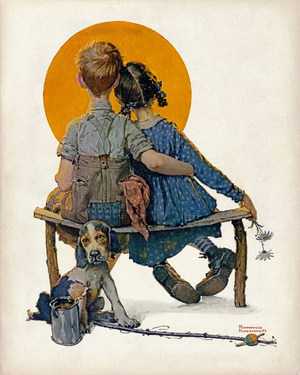
Mystic Museum of Art will present Norman Rockwell's Saturday Evening Post Covers: Tell Me a Story, organized by the Norman Rockwell Museum in Stockbridge, MA. The highlight of the MMoA Year of Narrative Art, the exhibition will run from June 18 through September 18.
The exhibition will present all 323 of the legendary covers created for The Saturday Evening Post by the renowned American painter and illustrator, Norman Rockwell (1894-1978). In doing so, the exhibition brings together two giants of American cultural history: The Saturday Evening Post, which chronicled "American history in the making" for nearly 200 years, and Norman Rockwell, who captivated the American public by the sheer visual appeal, historic detail, and narrative brilliance of his art for more than four decades. Taken together, Rockwell's Saturday Evening Post covers detail Americans' lives and the history they shared for 47 years.
Under the theme of "Tell Me a Story," MMoA will invite audiences, through tours, talks, and gallery activities to relate their own stories, to ask whose narratives are missing, and why. The editorial constraints and prejudices he labored under honed Rockwell's , commitment to social commentary. In later works for other publishers, he expanded on themes of racial inequity and discrimination.
"MMoA already had an important collection of American art," commented MMoA Executive Director,
Susan Fisher. "Now, the opportunity to work with an institution of international stature like the Norman Rockwell Museum puts exceptional traveling exhibitions within our reach, and the reach of those we serve."
Born in New York City on February 3, 1894, Norman Percival Rockwell is considered by many be one of America's greatest artists. From the beginning, he wanted to be an illustrator. He left public school at the age of 14 to attend the Chase Art School. He went on to study at the prestigious National Academy of Design and then at the more progressive Art Students League. At the League, he worked with such famous artists as George Bridgman and Thomas Fogarty.
It was a propitious time for an aspiring illustrator. The "Golden Age of Illustration" was a period of unprecedented excellence in book and magazine illustration, spanning the decades before and after the turn of the 20th Century, in the wake of the Industrial Revolution. Technical advances in papermaking and the reproduction of art made it possible to produce affordable art images for America's growing middle class while artists found employment and inspiration in narrative graphic art-among them
Howard Pyle, Maxfield Parrish, J.C. Leyendecker, N.C. Wyeth, and Frederick Remington.
Amidst this burgeoning art market, Rockwell won his first important commission when he was just 18: an illustration for Carl H. Claudy's Tell Me Why: Stories about Mother Nature. It was the beginning of a profession that he honed devotedly for the next 65 years.
The young Rockwell realized another dream when his art was published by the Boy Scouts of America's Boys' Life, and again when he became the publication's art editor in 1913. In 1916, with the assistance of cartoonist Clyde Forsythe (with whom he shared a studio) Rockwell successfully submitted his first cover painting, Mother's Day Off, for The Saturday Evening Post. He was only 22.
It was a defining achievement. From the early years of the century to the 1960s, The Saturday Evening Post was one of the most widely circulated and influential magazines in America. Its rich mixture of fiction, non-fiction, cartoons, and features reached millions of homes every week-easily the most prominent and versatile setting possible for his brilliantly narrative art. He took the opportunity seriously. Throughout his long career, Rockwell rarely took vacations from his studio. He worked meticulously from props and models, taking up to six months to create a single cover painting.
Rockwell's earnest and unpretending attitude to his work also characterized his subject matter. "I showed the America I knew and observed to others who might not have noticed" he reflected. He loved looking at the people around him: middle class children, families, and adults, as they played, worked, visited a doctor, or fixed a flat tire. He had an eye for everyday settings. By turns humorous and deeply moving, Rockwell's subjects found an enthusiastic public. According to The Saturday Evening Post, his work helped raise its subscription base to 6,900,000 nationwide by 1960.
While the "Golden Age of Illustration" waned through the 30s and 40s, Rockwell's popularity increased. His work appeared both on the covers and in the stories of The Saturday Evening Post into the 60s. His last cover for the Post, "Portrait of John F. Kennedy" was published on December 14, 1963, a week after Kennedy's assassination.
To bring such a vast range of imagery and subject matter into focus, MMoA will present a series of talks and events focusing on specific aspects of his art. All events will be posted on the Museum's website at
www.MysticMuseumofArt.org and publicized in eblasts. For information about tours or activities for groups, please call MMoA at 860.536.7601.
Comments
To post a comment, you must
register and
login.



